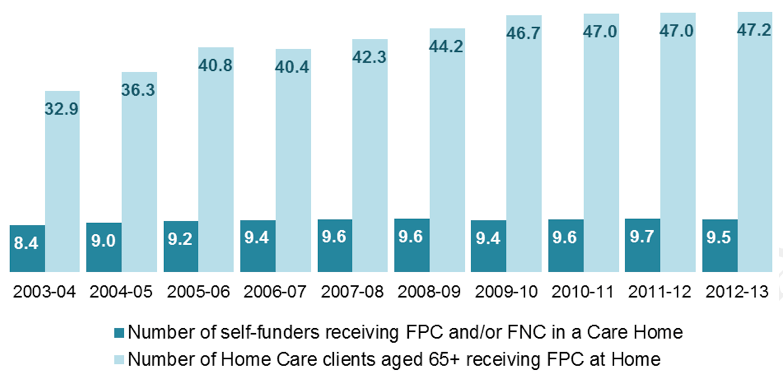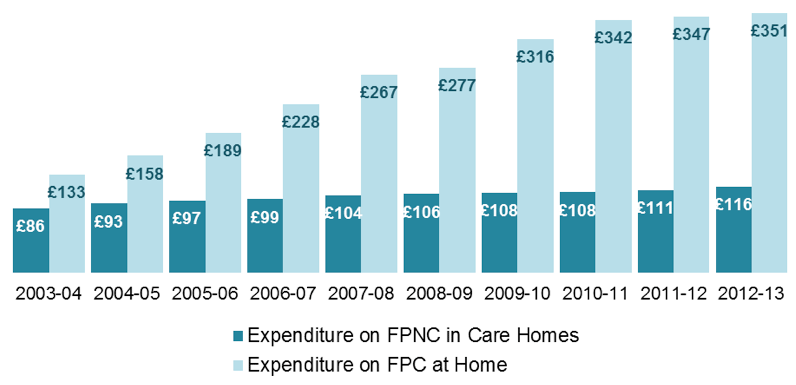Free personal and nursing care, Scotland, 2012-13
Information on the number of clients receiving free personal and nursing care services in Scotland, with expenditure figures.
This document is part of a collection
2. Main points
Number of clients
Over 77,000 people in Scotland benefit from Free Personal Care, with more than 30,000 people in Care Homes and over 47,000 people living in their own home.
Figure 1: People receiving FPNC (thousands)

Care Homes
The overall number of older people in care homes has reduced slightly since the Free Personal and Nursing Care policy was introduced, from around 32,000 in 2003-04 to just over 30,000 in 2012-13.
The number of people in Scotland receiving Free Personal Care and/or Free Nursing Care (FPNC) payments to help pay their Care Home fees increased steadily in the first few years of the policy and in 2012-13 there were nearly 9,500 people receiving Free Personal Care payments. These payments are available to self-funding care home residents who have assets (including property) worth more than £25,250 (from April 2013). Nearly a third (31.5%) of residents in 2012-13 received FPC payments.
The remaining 70% of care home residents are publicly funded. These residents contribute to their care home fees from their pensions and any other income they may have. The local authority funds the balance which will be greater than the free personal and/or nursing care payments received by self-funding Care Home residents.
Nearly two-thirds (65% in 2012-3) of people receiving the Free Personal Care payments also receive the Free Nursing Care payment (around 6,100 residents in 2012-13).
Home Care
The number of older people receiving personal care services in their own homes has increased from 33,000 in 2003-04 to nearly 47,000 in 2012-13. Since July 2002, Local Authorities in Scotland can no longer charge for these services.
This large increase in people receiving services in their own homes reflects an increasing older population and a move away from long-term care in hospital and care homes, towards providing care in a person's own home for as long as possible.
People receiving personal care services at home received on average 6.9 hours of care each week in 2003-04. This has risen steadily to 8.4 hours of care per week in 2012-13, showing that people receiving care at home have increasing levels of need.
In 2012-13, 94% of all older people receiving Home Care services also received personal care as part of their care package. This has increased each year since 2003-04, when only 57% of clients received personal care.
Expenditure
Note that the expenditure figures presented for 2012-13 are broadly comparable to previous years but may differ slightly for some areas due to changes made to the 2012-13 Local Government Finance Return (LFR).
Figure 2: Expenditure on FPNC (£ millions)

The amount spent by Local Authorities on FPNC payments to self-funding Care Home residents has increased each year from £86 million in 2003-04 to £116 million in 2012-13. This reflects the increasing number of self-funders up until 2008-09 and the annual increases in the FPNC payments from April 2008. All of this is new money arising from the FPNC policy.
Expenditure on FPNC payments to self-funding Care Home residents has increased by 4.4% in the last year to £116 million in 2012-13. This is accounted for by the increase in the FPNC payments and an increase in the proportion of people who receive FNC.
The amount spent by Local Authorities on providing personal care services to older people in their own home has risen from £133 million in 2003-04 to £351 million in 2012-13. Large increases in expenditure in the early years of the policy have gradually diminished and recent years show much smaller rises with an increase of only 1% in 2012-13. The overall increase in expenditure over the last 8 years reflects the fact that an increasing proportion of older people are cared for at home, rather than in hospital or care homes; that increasingly Home Care workers are providing personal care services rather than domestic services; and that people living at home have increasing levels of need. It should be noted that this is not all new spend arising from the FPNC policy, but prior to the policy Local Authorities could generate income by charging people for these services.
Contact
Email: Steven Gillespie
There is a problem
Thanks for your feedback